|
Rotten Library > Medicine > Eugenics
Eugenics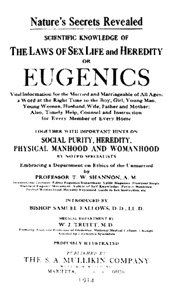 Eugenics means selective breeding -- not in the sense that you are individually selective regarding persons with whom you breed, but rather that someone else is pulling the strings in order to get a specific result. Eugenics techniques are used all over the world, every day, for all manner of God's creatures, but if you try using them on humans, people get very upset.
Eugenics means selective breeding -- not in the sense that you are individually selective regarding persons with whom you breed, but rather that someone else is pulling the strings in order to get a specific result. Eugenics techniques are used all over the world, every day, for all manner of God's creatures, but if you try using them on humans, people get very upset.
The theory behind eugenics is simple: When good people bone good people, good babies with good genes result. The trouble comes when trying to apply eugenics in an organized way to society, with the biggest problem being that someone has to decide who the "good people" are. Anyone who concludes that he or she is qualified to make this determination is generally the last person in the world who should have such power. Early human civilizations had no special qualms about killing children who were sick or deformed, although they were not likely thinking about the genetic repercussions of doing so. The concept of selective breeding to enhance certain traits reaches back to prehistoric times, about 10,000 years ago, at least as far as animals are concerned. "Eugenics" is the word for a social mandate to impose selective breeding on a human population for the presumed good of all mankind, with the operative word being "presumed."
The actual word "eugenics" was invented by Francis Galton, a British scientist who was distantly related to Charles Darwin. In addition to studying the weather and analyzing fingerprints, Galton was deeply interested in how intelligence and talent passed from generation to generation. He invented the word "eugenics" to describe how he believed his insights should be employed -- a social program designed to engineer racial superiority through coerced optimized breeding.
Darwin himself did not endorse his cousin's views, although he conceded that there was a certain logic in the view that natural selection was no longer working to improve the human species:
With savages, the weak in body or mind are soon eliminated; and those that survive commonly exhibit a vigorous state of health. We civilized men, on the other hand, do our utmost to check the process of elimination; we build asylums for the imbecile, the maimed, and the sick; we institute poor-laws; and our medical men exert their utmost skill to save the life of every one to the last moment. There is reason to believe that vaccination has preserved thousands, who from a weak constitution would formerly have succumbed to small-pox. Thus the weak members of civilized societies propagate their kind. No one who has attended to the breeding of domestic animals will doubt that this must be highly injurious to the race of man. It is surprising how soon a want of care, or care wrongly directed, leads to the degeneration of a domestic race; but excepting in the case of man himself, hardly any one is so ignorant as to allow his worst animals to breed. Although some of Galton's observations on social mating and inheritance were scientifically inspired, the overall thrust of his musings on genetics tended toward an aggressive defense of colonial-style racism, with much discussion of Britons -- and especially upper-crust British nobility -- as the master race, best suited to govern the "lower races," especially people of (any) color. (The fallacy of this view is painfully obvious.) Building on Galton's ideas, a small group of intellectuals seized on the idea of eugenics and began working to promote the idea to governments and other cultural institutions. They succeeded in winning support from such luminaries as a young Winston Churchill who served as vice president of the First International Congress of Eugenics in 1912, and the Catholic Church. The esteemed elders of the Church had no beef with using eugenics to stamp out "undesirable" traits and prevent race-mixing, although they did object to the use of contraception. The 1914 edition of the Catholic Encyclopedia explained their position:
Vasectomy or ligature of the Fallopian tubes is no remedy against concupiscence; and even if it were, mutilation could not be permitted as a means of avoiding temptation. The operation would open the door to immoral practices which would constitute a worse evil than the one avoided. Being in itself slight and almost painless, it would be useless as a punishment for criminals or as a deterrent for others. If the principle were admitted it would encourage the abuse of matrimonial relations. The welfare of the State, if seriously threatened by the degenerate, could be better protected by segregation. Therefore the operation is not permissible, except as a necessary means to bodily health, and consequently except for this necessity may not be performed even with the patient's consent. The Church has never regarded the marriage of degenerates as unlawful in itself: they cannot be deprived of their right without a grave reason. Even eugenicists like Dr. Saleeby and Dr. Havelock Ellis disapprove of compulsory surgery. As for compulsory segregation it seems to be both right and good, provided that all due safeguards are taken in respect of the grades of feebleness.
America had already had its fair share of racial troubles, from the genocide of the continent's original inhabitants to longstanding laws against interracial marriage to the "single drop" rule. A number of factors fed racial discontent in the U.S. as the 20th century began -- the emancipation of blacks, a flood of immigration, the resurgence of the Ku Klux Klan and an economic depression. The American eugenics movement took on steam with the discovery of genetic coding and the rise of such revolutionary figures as Margaret Sanger, a nurse who has been lionized by history and the abortion rights movement as an early advocate of contraception education. Sanger was a screaming racist and a founding member of the Eugenics Society of America. Among other things, she advocated the sterilization of the mentally and physically disabled and endorsed the use of birth control to suppress what she saw as the tendency of the lower classes and "inferior races" to breed like rabbits. Later, she apparently reformed her views (although a substantial amount of controversy endures on this topic). Sanger was hardly alone in her views. During the first 40 years of the 20th century, Americans embarked on a eugenics program that was in many ways as ambitious in scope as any of Adolf Hitler's wet dream. In 1921, then-vice president and future president Calvin Coolidge wrote an anti-immigration rant for Good Housekeeping Magazine in which he bemoaned the mix of good Nordic (i.e., white) stock with "inferior" races:
There are racial considerations too grave to be brushed aside for any sentimental reasons. Biological laws tell us that certain divergent people will not mix or blend. The Nordics propagate themselves successfully. With other races, the outcome shows deterioration on both sides. Quality of mind and body suggests that observance of ethnic law is as great a necessity to a nation as immigration law.
Other prominent American supporters of eugenics included Alexander Graham Bell, inventor of the telephone, biologist Charles Davenport, steel magnate Andrew Carnegie, Henry Ford, Charles Lindbergh and coprologist Dr. John Harvey Kellogg. Several U.S. states instituted a variety of eugenics-inspired laws -- including bans on mixed-race marriage and the first laws in history to compel the sterilization of the "unfit" or disabled. Many of these laws remained on the books for decades. Virginia's forced sterilization law was upheld by the U.S. Supreme Court in an opinion written by Oliver Wendell Holmes Jr., now remembered by history as one of the greatest legal minds of the 20th century. Holmes not only upheld the compulsory sterilization law; he complained that it was not broad enough.
We have seen more than once that the public welfare may call upon the best citizens for their lives. It would be strange if it could not call upon those who already sap the strength of the State for these lesser sacrifices, often not felt to be such by those concerned, in order to prevent our being swamped with incompetence. It is better for all the world, if instead of waiting to execute degenerate offspring for crime, or to let them starve for their imbecility, society can prevent those who are manifestly unfit from continuing their kind. The principle that sustains compulsory vaccination is broad enough to cover cutting the Fallopian tubes. [...] At least 60,000 people were involuntarily sterilized for the greater good of eugenics in the United States, and that number is almost certainly a whitewash of a substantially more depressing reality. The figure also fails to include the effects of a wide array of secretive medical experiments conducted under the auspices of the U.S. government, such as feeding radioactive mush to the mentally disabled.
Although America had incubated the eugenics movement, Germany mechanized it to levels of efficiency never seen before (and hopefully never to be seen again). The Germans decided that their nation had to restore its pure blonde, blue-eyed Aryan heritage by purging foreign bloodlines, particularly Jews. Putting aside the ensuing carnage for the moment, this concept is hilariously, ludicrously wrong. The mythopoetic blue-eyed ideal human race that dominated the Nazi imagination was itself a bastardization of the genuine Aryan stock, brought about by race-mixing. The original Aryans were Semites from Iran, more closely related to Jews than to Scandanavians.
American eugenicists were proud of inspiring Germany's program, while American government officials eyed Hitler's progress with envy. Many wrote that Germany's efforts would be the seed of a worldwide movement and looked forward to the day when America's leaders would follow the Nazi example. Although the earlier efforts had largely concerned themselves with overt "unfitness", the subtext of Jewish inferiority and other racial hate had continued to play out at every level of German society. It didn't take long for this aspect of the Nazi agenda became clearer. In 1935, the Nazis passed a law requiring couples to receive "racial hygiene" counseling before marriage, including answering questions about whether they had any Jewish blood. The government cranked out propaganda films intended to discourage race mixing. Jews and Gypsies were the biggest targets, and blacks, Slavs and gays were all designated "unfit" by the Reich. As we all know (well, most of us), the Germans quickly determined that sterilization was a slow process, and that genocide went much faster. Although the Holocaust was arguably carried out in the name of eugenics, the scope of what happened next far exceeded anything Galton probably envisioned and is best discussed elsewhere. By the end of World War II, suffice it to say, the excesses of the Nazi regime had crushed most of the momentum that the eugenicists had built during the preceding 40 years. Amazingly, the world's shock and horror at the depravities of the Nazi extermination machine failed to completely derail the eugenics movement. It lingered through the late 1960s and even into the '70s, but in a much quieter mode. By the early 1980s, forced sterilizations and anti-miscegenation laws had become a thing of the past. In part, the disenchantment with eugenics came about due to the fatal flaw with the concept, that of the self-appointed arbiter of what is a desirable trait and what is not. As civil rights and racial equality rose in prominence, the eugenicists began to slink off into the woodwork. The word is still bandied about, often by religious conservatives who believe that abortion rights and family planning programs are camouflaged eugenics programs. However, nearly everyone advancing this argument is anti-abortion first, and anti-eugenics second.
Fortunately, perhaps, there is little foreseeable use for the concept of controlled breeding, sterilization of "undesirables" and anti-miscegenation laws. The idea of manipulating the human animal through selective breeding is obsolete. Future zealots who wish to "improve" the human race according to their own master plan will use the tools of genetic engineering to accomplish their goals. Why mess around with people's sex lives when you can just inject them with an RNA retrovirus and magically remove all the undesirable qualities from their DNA? No muss, no fuss, no Nuremberg Tribunal!
|
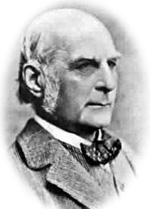 The idea appears to have first been extended to humans by Plato, of all people, who recommended in his Republic that the ruling class should be carefully maintained by a secret program of selective breeding in which seemingly random orgies would be staged in order to breed desirable qualities. Strangely, this program tends to be left out of high school history books.
The idea appears to have first been extended to humans by Plato, of all people, who recommended in his Republic that the ruling class should be carefully maintained by a secret program of selective breeding in which seemingly random orgies would be staged in order to breed desirable qualities. Strangely, this program tends to be left out of high school history books. 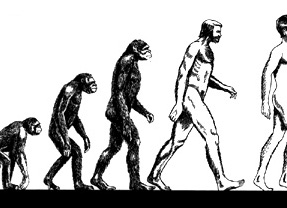 Galton believed people should be bred for success just like cattle. That is not a rhetorical flourish -- Galton literally argued that people should be bred in the same manner as cattle, racehorses and dogs.
Galton believed people should be bred for success just like cattle. That is not a rhetorical flourish -- Galton literally argued that people should be bred in the same manner as cattle, racehorses and dogs.  In the wake of
In the wake of 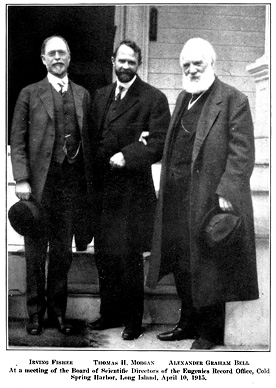 Later, as president, Coolidge signed the Immigration Restriction Act of 1924 -- which targeted dirty Italians and those dirty, dirty Jews -- declaring that "America must remain American!" The law clamped lid on the good old "melting pot", but then that was mostly a myth to begin with.
Later, as president, Coolidge signed the Immigration Restriction Act of 1924 -- which targeted dirty Italians and those dirty, dirty Jews -- declaring that "America must remain American!" The law clamped lid on the good old "melting pot", but then that was mostly a myth to begin with.
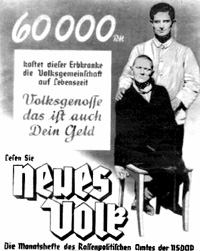 The man perhaps most responsible for the success and influence of the American eugenics movement was also unintentionally responsible for its eventual fall from grace. Oil tycoon John D. Rockefeller financed hundreds of thousands of dollars of research through his "philanthropic" foundations, and the inflation-adjusted equivalent of millions of dollars given directly to Germany's budding Nazi pursuit of a master race, including funds that indirectly helped underwrite the playscape of
The man perhaps most responsible for the success and influence of the American eugenics movement was also unintentionally responsible for its eventual fall from grace. Oil tycoon John D. Rockefeller financed hundreds of thousands of dollars of research through his "philanthropic" foundations, and the inflation-adjusted equivalent of millions of dollars given directly to Germany's budding Nazi pursuit of a master race, including funds that indirectly helped underwrite the playscape of  After absorbing the rhetoric of American eugenicists and the money of American "philanthropists," the Germans began an institutionalized eugenics program after Hitler took power in 1933. Initially, the program was directly based on U.S. eugenics laws. First, they mandated sterilization for anyone with an inherited condition such as congenital blindness or deafness, most forms of mental illness and alcoholism. This program prompted the New England Medical Journal to gush: "Germany is perhaps the most progressive nation in restricting fecundity among the unfit."
After absorbing the rhetoric of American eugenicists and the money of American "philanthropists," the Germans began an institutionalized eugenics program after Hitler took power in 1933. Initially, the program was directly based on U.S. eugenics laws. First, they mandated sterilization for anyone with an inherited condition such as congenital blindness or deafness, most forms of mental illness and alcoholism. This program prompted the New England Medical Journal to gush: "Germany is perhaps the most progressive nation in restricting fecundity among the unfit." As genetic science became more sophisticated in the 1990s, some scientists also began to tiptoe around the notion of controlled breeding again, although no one is suggesting such a plan be imposed by the government any more. Instead, researchers cautiously note that certain conditions -- such as
As genetic science became more sophisticated in the 1990s, some scientists also began to tiptoe around the notion of controlled breeding again, although no one is suggesting such a plan be imposed by the government any more. Instead, researchers cautiously note that certain conditions -- such as